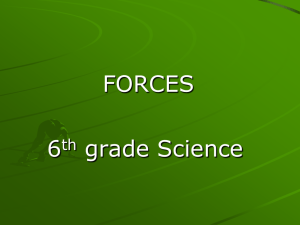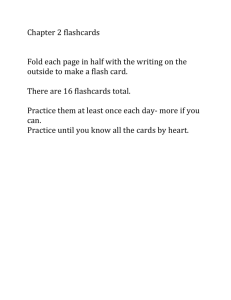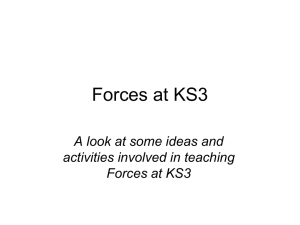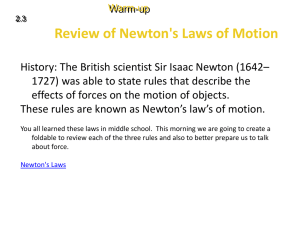Forces
advertisement
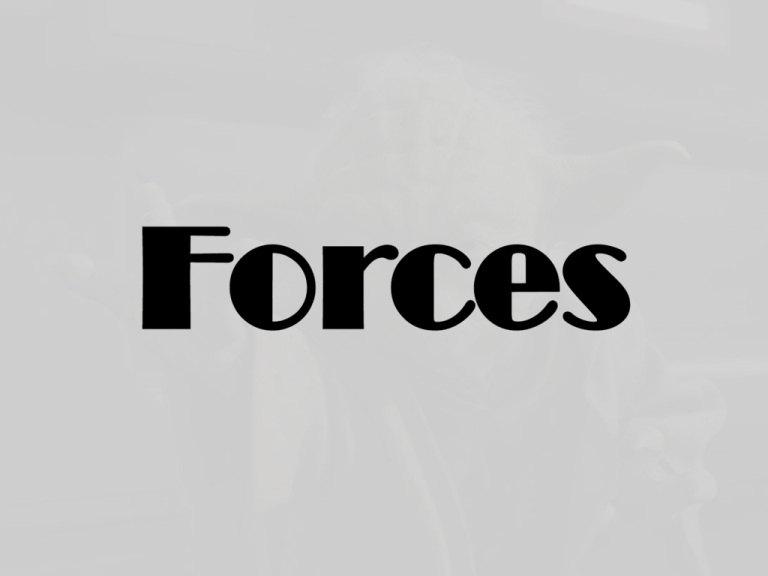
Forces One popular urban myth tells a story of a man who makes a wish from the top of the Empire State Building, then tosses a penny off the roof. Over 1,000 feet below, a pedestrian is hit by the speeding penny and killed. …Good luck, huh? What causes the penny, an object we may see and handle every day, to become a weapon? Killer Pennies! • Is it heavy? – Pennies aren’t very heavy, but neither is a bullet? • Is it going too fast? – Dropped from that height, an object has a long way to fall – plenty of space to speed up. • So how does it speed up? – Gravity. …But gravity is a single FORCE. One of several forces, in fact, that are working on that penny. – In fact, this myth is false. A penny is simply not heavy enough and wouldn’t have enough speed to kill a person walking below. • But a roll of pennies on the other hand…. • http://science.howstuffworks.com/science-vs-myth/everydaymyths/threw-penny-off-the-empire-state-building.htm • A FORCE is a push or a pull. – Gravity pulls cats down toward the Earth. – Space shuttles use explosive fuel to push off from the ground – Your weight pushes down on your chair. • All forces have size and direction. • Forces can transfer energy. • Forces are measured in Newtons (N). – 1 Newton is about the weight of a stick of butter. • There are many different kinds of forces • Some only work when two objects are directly touching each other. • Others can work “at long range.” • The forces that need direct contact are only working while the objects are touching. Once they are no longer touching, the force is gone. – Direct contact – friction, applied force • Forces that work at a distance are ALWAYS present, but if you’re REALLY far away, the force is nearly 0 (ineffective). – Distant forces – gravity, electrical, magnetic Applied Force • An APPLIED FORCE is a push or pull from one object put onto another object. – It covers a lot of things. • Pushing your siblings • Pulling a wagon • Chewing food • Flying a kite • Etc., etc., etc. – It’s basically every force directly between two objects, as long as it’s not… Friction • FRICTION is the force between two surfaces as they slide past each other. –Friction always resists motion. • If you are trying to move forward, friction is pushing backward. • If a sled is moving downhill, friction pulls uphill. • If a penny is falling from the Empire State Building, friction pulls up. Gravity • Gravity is the first of the distant forces. • GRAVITY is the pull on everything from the center of the Earth’s mass. – Really, everything has some small gravity. The larger the mass, the larger the pull. • What keeps the Earth in orbit around the Sun? • What keeps the moon in orbit around the Earth? • What keeps you on the floor? • Does Mr. Hibner have gravity? Electrical • ELECTRICAL FORCE is the push or pull from electrical charges. – What happens if you rub a balloon on your head and pull it away slowly? – “Opposites attract” – there are positive and negative charges. • “-” and “+” are pulled TOWARD each other. • “-” and “-” are pushed AWAY FROM each other. • “+” and “+” are also pushed AWAY FROM each other. Magnetic • MAGNETIC FORCE is a push or pull based on magnetic poles. – What direction does a compass always point? • Does it ALWAYS point that way? – Again, “opposites attract” • “N” and “S” are pulled TOWARD each other. • “N” and “N” are pushed AWAY FROM each other. • “S” and “S” are also pushed AWAY FROM each other. • There may be many different forces acting on objects at the same time. • When you look at all of the forces acting on an object, some things cancel each other out. – When you play tug-o-war, two sides are each applying a force on the flag in the middle. Two things can happen: • One team is stronger than the other and pulls the flag their way • Both teams are equally strong, and the flag stays right in the middle. Force diagram • When you add up all of the forces that are working on an object at once, the result is called a NET FORCE. • The net force determines the motion of an object. • If the net force = 0, then the object’s motion doesn’t change. – If it’s moving, it stays moving. – If it’s stopped, it stays stopped. • If the net force > 0, the result is ACCELERATION. Doing the Math • So, how do I find out if two forces are balanced or unbalanced? • If they are pointing in the same direction, ADD THEM TOGETHER • If they are pointing in different directions, SUBTRACT THEM. 20 N 10 N 50 N 20 N This picture tells me that Batman is standing,… …waiting. Justice never sleeps. How can I tell that Batman isn’t trying to move? How can I tell that Batman isn’t falling? What is the net force on the cheetah? What direction will this Angry Bird accelerate in? • If two forces cancel each other out, then they are called BALANCED FORCES. • If two forces DO NOT cancel each other out, then they are called UNBALANCED FORCES. • The result is acceleration. – This skydiver will accelerate toward the ground. • Good luck with that! Where do you see forces at work? • Individually, come up with 2 examples of forces at work in life situations. • With a partner, share your examples. Try to identify if they are balanced or unbalanced forces. – Where is the net force pointing? • As a class, we will discuss a few examples. Practice Draw a force diagram for a bird that is flying forward through a windstorm. Show that some forces are more powerful than others by their length or width. Are the forces balanced or unbalanced? What is the net force on the bird? Will the bird accelerate? If so, in which direction? • Draw a force diagram for a baseball being hit by a player. Show that some forces are more powerful than others by their length or width. Are the forces balanced or unbalanced? What is the net force on the ball? Will the ball accelerate? If so, in which direction? • Draw a force diagram for a car traveling at EXACTLY 60 mph down the highway. Show that some forces are more powerful than others by their length or width. Are the forces balanced or unbalanced? What is the net force on the car? Will the car accelerate? If so, in which direction? • Draw a force diagram for a steel beam being suspended by a crane. Show that some forces are more powerful than others by their length or width. Are the forces balanced or unbalanced? What is the net force on the beam? Will the beam accelerate? If so, in which direction? • Draw a force diagram for a sled being pushed down a hill. Show that some forces are more powerful than others by their length or width. Are the forces balanced or unbalanced? What is the net force on the sled? Will the sled accelerate? If so, in which direction? • Draw a force diagram for a box being pushed across a desk. The box has a weight of 50 N. The force of friction is 45 N, and the force of the push is 60 N. Show that some forces are more powerful than others by their length or width. In case you forgot what a box looks like. Are the forces balanced or unbalanced? What is the net force on the box? Will the box accelerate? If so, in which direction? • Draw a force diagram for an apple hanging from a branch on a tree. The weight of the apple is 0.1N. Show that some forces are more powerful than others by their length or width. Are the forces balanced or unbalanced? What is the net force on the apple? Will the apple accelerate? If so, in which direction? Constant Velocity • If a non-zero NET FORCE causes an acceleration, then what does a net force of 0 cause? • A car drives down the highway with a CONSTANT SPEED. Draw a force diagram for this car. • When driving, you always need to press the gas (applied force) just a little to keep up your speed. • A NET FORCE of 0 means that the object’s speed isn’t changing – THIS DOES NOT MEAN THE SPEED IS ZERO!!! Newton’s Laws • Isaac Newton • 1st law – An object at rest stays at rest (an object in motion stays in motion) until an outside force acts on it. – Called “INERTIA” • 2nd law – Force = mass*acceleration – F = m*a • 3rd law – For every action, there is an equal and opposite reaction. A basketball is sitting on a table. Jake walks by and taps it on the side. Draw a force diagram for the ball when Jake’s hand hits it. What will happen to the ball immediately after the hit? – 5 seconds later? – 5 minutes later? – Which law does this demonstrate? Ally likes fishing. After seeing the bobber dip under the water, she pulls back on the rod and starts to reel in this fish, who is struggling to get away. Draw a diagram for the fish, assuming the line is straight forward. What happens if the fish pulls back too hard? Which law does this demonstrate? Look at Ally’s fish again. The weight of the fish is 20 N. The fish is pulling back with a force of 60 N, and Ally is pulling forward with a force of 70 N. What is the value of the applied force on the fish that helps it swim? If the fishing line is unbreakable, which direction does the fish go? • What if Ally only pulls with 60 N? 50 N? What happens if the fishing line can only hold 150 N of force? 100 N? Driving down the highway, you are looking forward and a bug splats on the windshield. Draw a diagram for the bug as it hit, assuming it was not moving. What happens when the bug hits the windshield? Does the bug slow down? Does the car slow down? What law do these things demonstrate? Identifying Newton’s Laws • Where do you see Newton’s Laws acting in these pictures? 1) Object in motion stays in motion until an outside force acts on it 2) F =m*a 3) For every force, there is an equal and opposite force. We will begin measuring forces – comparing balanced and unbalanced forces using numbers. This makes it easier for us to tell for sure whether one force is stronger than another. For force, the units we measure in are called “NEWTONS,” named after Sir Isaac Newton. Center of Mass • When we draw a force diagram, do we ALWAYS have to draw the picture? • I mean…my art skillz aren’t so good…. • And sometimes the stuff is hard to draw…. • When we draw a force diagram, we should always draw the force acting on the CENTER OF MASS – the point where the mass is all balanced out. • For this reason, you can draw every object as a box or a sphere, if you’d like!

